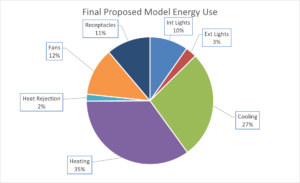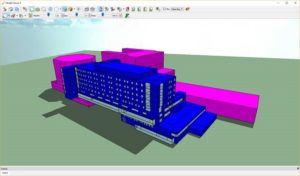Building modeling is essential in building design, especially when aiming for a Net Zero Energy building, which is what one corporate client was after. In this example, a third-party energy services company (ESCO) was employed for building modeling services to ensure the building would be able to reach Net Zero Energy.
CHALLENGES
The structure is a renovated building modified with energy efficiency in mind, aiming to offset all energy use through onsite renewable energy production. Due to the project being an existing building, several Energy Conservation Measures (ECMs) were limited. Challenges arose from some of the building’s features: its location in a climate zone not conducive to certain passive energy strategies typically used in Net Zero buildings, building operations that run 24/7, and the large data center operating within the building.
CALCULATIONS AND CONCLUSION
A maximum building Energy Use Intensity (EUI) goal was calculated based on the amount of space available for solar panels. Historical utility bills and energy modeling were used to determine the finished building’s current EUI score, the initial building design’s EUI core, and the ECMs needed to reach the EUI goal.
Ultimately, the decision was made during the design process not to pursue Net Zero Energy. However, most of the ECMs that the third-party ESCO recommended were still implemented, including installing a rooftop solar array. The building went on to receive LEED Gold from the USGBC.

ECM STRATEGIES EVALUATED
- Insulation to the existing walls and roof structure.
- Floor to ceiling existing windows with smaller, electro-chromatic glazing windows.
- Various HVAC strategies for best energy efficiency, including air-source heat pumps, water-source heat pumps, and existing DX system replacement for higher efficiency equipment.
- Lighting to ensure spaces were not using excessive lighting power.
- Building envelope tightening via Infiltration analysis.
- Combined HVAC control strategies with occupant placement so only building portions in use would be conditioned for the day and night occupant shifts.
- Plug load strategies to minimize miscellaneous energy use in the building.
- Window area reduction impact via daylight modeling to ensure the amount of daylight entering the building would not be negatively impacted and whether light shelves impact window area reduction.


